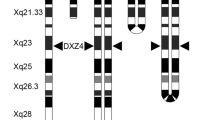Summary
A comparison of the sequence of DNA replication in an isodicentric (idic) X chromosome was made between peripheral blood lymphocytes and skin fibroblasts from a 33-year-old female with primary amenorrhea, somatic stigmata of Turner syndrome, and normal stature and intelligence. The patient had a karyotype 45,X/46,X,idic(X)(q27.1) in lymphocytes and 46,X,idic(X)(q27.1) in skin fibroblasts. Both centromeric regions of the idic X showed C-staining but only one primary constriction. BrdU-33258 Hoechst-Giemsa techniques were used to analyze regional DNA replication patterns. The idic X chromosome was always late replicating in lymphocytes and skin fibroblasts, except that about 1–2% of cells completed replication simultaneously in both normal and idic X chromosomes. Fifty-six percent of the asymmetric patterns in lymphocytes showed an equal proportion of early and late functional and non-functional centromere halves. In skin fibroblasts, 60.8% of cells were asymmetric: the functional half tended to replicate later than the non-functional half. Some differences were observed between these two cell types. As examples, band q23 was late replicating in lymphocytes, but early replicating in fibroblasts; q25 was intermediate to late replicating in lymphocytes, but one of the last bands to complete replication in fibroblasts. Thus, different cell typed influenced the replication kinetics in the idic(X). Furthermore, several variants of the replication sequence were found in both cell types. The findings support the hypothesis that the control of DNA replication in the inactive X chromosome is multifocal, and suggest that the active idic X chromosome replication may reflect a relative lack of self-control or heterogeneity of cell population.
Similar content being viewed by others
References
Baranovskaya LI, Egolina NA, Zakharov AF, Tsvetkova TG (1976) Isochromosome X in man: Different DNA replication pattern in the long arms. Hum Genet 33: 55–60
Biemont MC, Laurent C, Couturier J, Dutrillaux B (1978) Chronologie de la replication des bands des chromosomes sexuels dans les lymphocytes des sujets normaux et anormaux. Ann Genet 21: 133–141
De la Chapelle A, Stenstrand K (1974) Dicentric human X chromosomes. Hereditas 76: 259–286
Dewald G, Spurbeck JL, Gordon H (1978) Replication patterns of three isodicentric X chromosomes and an X isochromosome in human lymphocytes. Am J Med Genet 1: 445–460
Eicher E (1970) X-autosome translocation in the mouse. Adv Genet 15: 175–259
Epplen JT, Siebers JW, Vogel W (1975) DNA replication patterns of human chromosomes from fibroblasts and amniotic fluid cells revealed by Giemsa staining technique. Cytogenet Cell Genet 15: 177–185
Latt SA (1975) Fluorescence analysis of late DNA replication in human metaphase chromosomes. Somatic Cell Genet 1: 293–321
Latt SA, Willard HF, Gerald PS (1976) BrdU-33258 Hoechst analysis of DNA replication in human lymphocytes with supernumerary or structurally abnormal X chromosomes. Chromosoma 57: 135–153
Maraschio P, Scappaticci S, Ferrari E, Fraccaro M (1977) X chromosomes attached by their long arm: Replication autonomy of the short arm adjacent to the inactive centromere. Ann Genet 20: 179–183
Maraschio P, Simoni G, Terzoli GL, d'Alberton A, Crosigani PG (1980) X chromosomes attached by their short arm: Presence of an inactive centromere influences the replication patterns. Ann Genet 23: 208–212
Mirzayants GC, Baranovskaya LI (1978) X-X translocation in a patient with gonadal dysgenesis and the problem of phenotype-karyotype correlation. Hum Genet 40: 249–257
Mutchinik O, Casas L, Ruz L, Lisker R, Lozano O (1981) Symmetric replication patterns and sex chromatin bodies formation of an idic(X)(p22.3::p22.3) chromosome. Hum Genet 57: 261–264
Paris Conference (1971) Standardization in human cytogenetics. Birth Defects 8: 12–23
Perry P, Wolff S (1974) New Giemsa method for the differential staining of sister chromatids. Nature 251: 156–158
Sarto GE, Therman E (1980) Replication and inactivation of a dicentric X formed by telomeric fusion. Am J Obstet Gynecol 136: 904–911
Schmidt M, Stolzmann WM, Baranovskaya LI (1982) Replication variants of the human inactive X chromosome. I. Variability within lymphocytes of single individuals. Chromosoma 85: 405–412
Sears ER, Camara A (1952) A transmissible dicentric chromosome. Genetics 37: 125–135
Therman E, Sarto GE, Patau K (1974) Apparently isodicentric but functionally monocentric X chromosome in man. Am J Hum Genet 26: 83–92
Willard HF (1977) Tissue-specific heterogeneity in DNA replication patterns of human X chromosomes. Chromosoma 61: 61–73
Willard HF, Latt SA (1976) Analysis of DNA replication in human X chromosomes using BrdU-Hoechst techniques. Am J Hum Genet 28: 213–227
Willard HF, Breg WR (1980) Human X chromosomes: synchrony of DNA replication in diploid and triploid fibroblasts with multiple active or inactive X chromosomes. Somatic Cell Genet 6: 187–198
Yu CW, Chen H, Morrison J (1980) Kinetics of DNA replication in a dicentric X chromosome formed by long arm to long arm fusion. Hum Genet 56: 71–79
Yu CW, Priest JH, Byrd JR (1982) DNA replication sequence in a dicentric (functionally monocentric) X chromosome formed by the joining of two X chromosomes at region p22. Am J Med Genet 11: 305–317
Yunis JJ (1976) High resolution of human chromosomes. Science 191: 1268–1270
Author information
Authors and Affiliations
Rights and permissions
About this article
Cite this article
Lin, M.S., Wilson, M.G. The sequence of DNA replication in an iso-dicentric X-chromosome in peripheral blood lymphocytes and skin fibroblasts from the same individual. Hum Genet 65, 139–143 (1983). https://doi.org/10.1007/BF00286650
Received:
Revised:
Issue Date:
DOI: https://doi.org/10.1007/BF00286650




